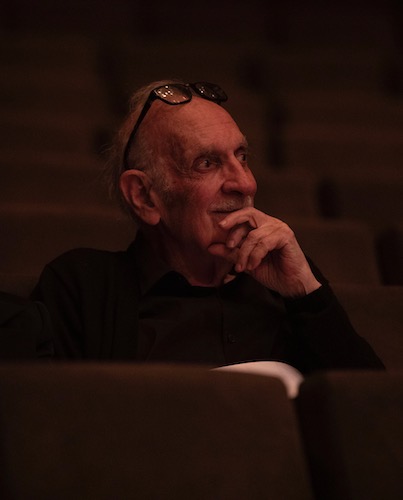A feast of George Crumb’s distinctive, haunting piano music from Kaleidoscope MusArt

George Crumb’s “Makrokosmos” Books I and II were performed by Kaleidoscope MusArt Sunday at Clarke Recital Hall in Coral Gables. Photo: Tristan Cook.
Some composers follow prevailing cultural paths. Others march to their own drummer and artistic aesthetic.
Like John Cage and Lou Harrison, George Crumb is an American original. Eschewing the opposing ideologies of Schoenberg’s rigorous atonality or Copland’s American sound, Crumb has for decades created his own sonic palette. His musical world is replete with magical sonorities, extended instrumental techniques and unique musical notation.
Approaching his 90th birthday in October, his creative spirit remains unabated. Crumb’s new percussion quintet KRONOS-KRYPTOS was premiered just two weeks ago in New York, performed by the Chamber Music Society of Lincoln Center.
Crumb’s four books of Makrokosmos are a formidable collection of short works that summarize his unique musical impulses and pose formidable challenges to the performing artist. In the first of a two-concert marathon, Kaleidoscope MusArt presented Books I and II of Makrokosmos for amplified piano, each comprised of 12 pieces after the Zodiac, Sunday night at the University of Miami’s Clarke Recital Hall in Coral Gables. Books III and IV will be performed Tuesday night (see below).
Crumb has indicated that these performances may be the first complete traversal of the scores since their 1980 premiere in Buffalo. No less than seven pianists took turns playing Crumb’s singular vignettes.
Crumb requires the players to chant, whistle, speak and sing in addition to strumming or hitting the keyboard’s strings. The first bars of the initial “Primeval Sounds” are like dark rumblings from deep within the earth, evoked powerfully by Natsumi Ikenaga. A projection of Crumb’s notation in the shape of a cross accompanied “Crucifixus” (Capricorn) during which the player yells “Criste” before the music’s sudden quietness seemed to foretell the ebbing of life.
In “Music of Shadows” (for Aeolian Harp–Libra), strummed strings entrance the ear with harp-like sonorities. Whirling figures, sudden pianistic blasts and clusters played with arms and elbows ignited a flame indeed for “Spring Fire” (Aries). Jacob Mason, a contemporary music specialist, brought daunting technique and expertise to Crumb’s fiery minefield. A poetic touch, elegantly conveyed by Andrew Rosenblum, seemed like a dreamscape in the Love-Death Music of “Dream Images” (Gemini) that soon turns to quotations from Chopin’s Fantasie-Impromptu as if a childhood memory of piano practice.
Charming ripples of light open Book II as the sky brightens in “Morning Music” (Cancer). “Rain” (Death Variations – Pisces) resounds in fast, intricate fragments like raindrops. Larisa Soboleva’s strength and agility offered brightness amid the downpour. A sense of mystery pervades “Twin Suns” (Gemini). (Crumb’s projected score in the form of two suns accompanied Soboleva’s performance.)
Abrupt rhythms suggest Bartok and the Mussorgsky of Pictures at an Exhibition during “Gargoyles” (Taurus). Dan Sato’s brilliant execution of Crumb’s wild cadenza from pianistic Hades in “Tora! Tora! Tora!” (Scorpio) was a highlight of the evening, encompassing rapid hand crossings and runs up and down the keys. Nightmarish loud and soft reiterations of the Dies irae motif herald “A Prophecy of Nostradamus” like a cataclysm unleashed.
Eunmi Ko utilized a brush across the instrument’s strings as well as her own breathing to create special effects that would not have been out of place in a sci-fi movie during “Cosmic Wind” (Libra). The sheer simplicity of the concluding “Agnus Dei” (Capricorn) was memorable as Ko played with soft repose and sang in lovely tones. Emiri Nourishirazi and Sophia Pileggi also gave skilled, finely attuned performances of Crumb’s visionary cameos.
Kaleidoscope MusArt presents George Crumb’s Makrokosmos IV–Celestial Mechanics for Amplified Piano -Four Hands (and Six Hands) and Music for a Summer Evening (Book III) for Two Amplified Pianos and Percussion featuring pianists Young Kim, Akina Yura, Maria Sumareva, Redi Llupa and Inesa Gegprifti and percussionists Andrew Riley and Lucas Sanchez 8 p.m. Tuesday at UM Gusman Concert Hall in Coral Gables. Dorothy Hindman gives a pre-concert lecture at 7 p.m. kaleidoscopemusart.com
Posted in Performances
One Response to “A feast of George Crumb’s distinctive, haunting piano music from Kaleidoscope MusArt”
Leave a Comment
Mon Apr 29, 2019
at 5:32 pm
1 Comment
Posted May 01, 2019 at 8:34 pm by Dorothy Hindman
Thank you for covering this rare and unforgettable event. Kaleidoscope MusArt is a treasure for the Miami classical music community.